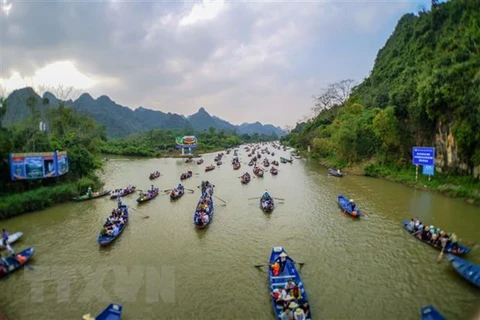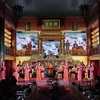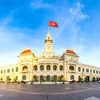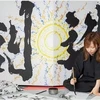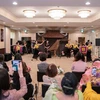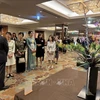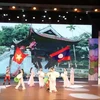Hanoi (VNS/VNA) - The annual pilgrimage festival to Huong Pagoda, a great religious site as well as a scenic complex, some 65km to the west of downtown Hanoi, has officially opened after closing due to COVID-19 pandemic.
Huong (Perfume) Pagoda, located in Huong Son commune, My Duc district, consists of a vast complex of Buddhist temples and shrines built on limestone Huong Tich mountains.
Every year, the site hosts a large number of pilgrims from all over the country. The pilgrimage festival starts from the 6th day of the lunar year, while the peak of the festival falls between 15th day of the first lunar month to 18th day of the second lunar month. Yet the spectacular landscape draws tourists also throughout the year.
Hundreds of pagodas and shrines are scattered along the Yen Stream including Chua Ngoai (Outer Pagoda) and Chua Trong (Inner Pagoda).
The centre of the complex is Huong Pagoda proper deep inside Huong Tich Cave.
Tourists take a boat trip from Duc Dock to Outer Pagoda, which was also named Tro Pagoda.
Huong Pagoda was built at the end of 17th century inside Huong Tich Cave, which was then almost totally destroyed during the French invasion in 1947. In 1988, the pagoda was rebuilt by late monk Thich Thanh Chan.
Visitors will find the phrase “Huong Tich Dong Mon” (The Gate of Huong Tich Cave) carved at the entrance of the cave after taking a stone stairway of 120 steps leading to the cave.
There remain traces of Tinh Do Vuong Trinh Sam (1739-1782), the 8th Lord of Trinh royal reign ruling the north of Vietnam. He ordered to carve on stones five Han Chinese characters when visiting the site in 1770.
Together with spiritual values, the site has lured tourists thanks to its natural landscape.
The Yen Stream with clear water surrounded with greenery of trees and plants. The site has its own attraction in different periods of the year with various flowers like red kapok, orchid and plum flowers in spring, and water lilies in autumn./.
Huong (Perfume) Pagoda, located in Huong Son commune, My Duc district, consists of a vast complex of Buddhist temples and shrines built on limestone Huong Tich mountains.
Every year, the site hosts a large number of pilgrims from all over the country. The pilgrimage festival starts from the 6th day of the lunar year, while the peak of the festival falls between 15th day of the first lunar month to 18th day of the second lunar month. Yet the spectacular landscape draws tourists also throughout the year.
Hundreds of pagodas and shrines are scattered along the Yen Stream including Chua Ngoai (Outer Pagoda) and Chua Trong (Inner Pagoda).
The centre of the complex is Huong Pagoda proper deep inside Huong Tich Cave.
Tourists take a boat trip from Duc Dock to Outer Pagoda, which was also named Tro Pagoda.
Huong Pagoda was built at the end of 17th century inside Huong Tich Cave, which was then almost totally destroyed during the French invasion in 1947. In 1988, the pagoda was rebuilt by late monk Thich Thanh Chan.
Visitors will find the phrase “Huong Tich Dong Mon” (The Gate of Huong Tich Cave) carved at the entrance of the cave after taking a stone stairway of 120 steps leading to the cave.
There remain traces of Tinh Do Vuong Trinh Sam (1739-1782), the 8th Lord of Trinh royal reign ruling the north of Vietnam. He ordered to carve on stones five Han Chinese characters when visiting the site in 1770.
Together with spiritual values, the site has lured tourists thanks to its natural landscape.
The Yen Stream with clear water surrounded with greenery of trees and plants. The site has its own attraction in different periods of the year with various flowers like red kapok, orchid and plum flowers in spring, and water lilies in autumn./.
VNA


